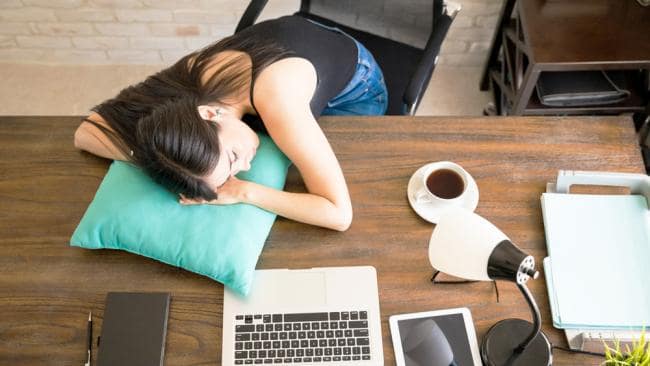Learn about brain health and nootropics to boost brain function
Napping 101: hacks for people who swear they can’t day-sleep


If health experts could have their way, we’d all be napping on the regular. Studies show that there’s more good in napping than just reducing fatigue, with naps also proven to improve our mood, immune functioning and memory recall.
In fact, people who nap at least three times a week may even live longer, thanks to a reduced risk of a heart attack.
“Napping is a skill we can all be cultivating because it’s really good for us,” sleep scientist Dr Carmel Harrington, author of The Complete Guide to a Good Night’s Sleep, tells bodyandsoul.
“The major issue is that people don’t understand the value of napping.”
Sounds good in theory, but what if you just can’t sleep when the sun is up? Dr Harrington has some tips.
1. Know the productivity value
Despite the fact Google, Mercedes Benz and NASA staff have access to EnergyPod chairs that are designed for sleeping on the job – many people still judge napping as a waste of valuable time.
“When people say ‘I don’t nap’, it could be the perception that napping in the day is lazy,” Dr Harrington says.
“We all have been brought up with the idea that we should be on the ball 24/7. We don’t even like sleeping at night half the time, let alone sleeping in the afternoon.”

But Dr Harrington says napping deserves a rebranding to make it our go-to energy booster, given it works similarly to caffeine without a subsequent crash.
“If we started to see napping as a tool for productivity rather than something that takes away from our productivity, I think people would have a different attitude towards it,” she says.
2. Learn some basic biology
Nobody bats an eye at an ambitious executive downing their third coffee for the morning in the pursuit of efficiency, but Dr Harrington says it’s worth noting that naps work similarly, yet more effectively.
It all comes down to turning down the “sleepy neurotransmitter” called adenosine that builds up the longer we have been awake.
“When we nap, we don’t produce adenosine and we actively degrade it so we have less of this sleepy neurotransmitter and our brain is refreshed and ready to go,” she explains.
Caffeine feels similar, but works quite differently by simply blocking the brain’s adenosine receptors, thus blinding us to the feeling of adenosine.
Trouble is, once the caffeine wears off, all that sleepiness suddenly hits and we can find ourselves having micro sleeps because we’re so weary.
3. Time it right
If you think you can’t nap, you might need to look at when you’re trying to have one because your body might not be ready.
Dr Harrington says that for most people, the best time of day for a nap is around 3 or 4pm when we have a natural dip in energy levels.
“It’s unlikely that you’ll need one at 10am and if you are having one then, it probably indicates that you didn’t get enough sleep the night before,” she points out.
“Having one in the afternoon works really well for students coming home from school or university – instead of wandering around the house during that lull, it’s good to have a 20-minute nap and when you wake up you will be much more productive.”

Source:BodyAndSoul
4. Cap it at 20 minutes
If you’re worried about losing precious minutes in your day to sleep, then know that all you should be napping for is 20 minutes max.
“Twenty minutes keeps you in light sleep,” Dr Harrington explains.
“If you go into deep sleep, which is 90 to 110 minutes, that will affect your ability to initiate sleep at night because you will have taken away some of your sleep drive. You also wake up from a deep sleep feeling groggy and awful.”
When your 20-minute alarm goes off, Dr Harrington suggests doing some star jumps, hula hooping or jogging on the spot.
“You’ll be ready to go for four or five more hours,” she says.
5. Take what sleep you get
You don’t have to spend the full 20 minutes dead-to-the-world – even if you only drift off for a few minutes, Dr Harrington says you’ll get the same body benefits.
“Whether you sleep for five, 15 or 20 minutes, your brain is refreshed,” she says.
“Sometimes you will lay there for 20 minutes and then get up, which is okay too – you just weren’t ready to go to sleep.”
If you don’t sleep, Dr Harrington says it could be that you weren’t actually tired enough and maybe taking a walk in the fresh air is what you need for a brain re-set.
If you have tried napping around 3pm and had no success, you may need to tweak the time to suit your chronotype [natural body clock].
“If you’re an ‘owl’ and like to go to bed late at 11pm or 12am or 1am, your physiological dip in alertness may occur at 5pm or 6pm,” Dr Harrington points out.
6. Legitimately can’t nap? Try these energy-boosters instead
If you’re feeling bleary-eyed but your job/kids/to-do list genuinely render that impossible, Dr Harrington says there are ways of replicating the energy boost.
“One of the ways to alert your brain and make it refreshed is to exercise or surround yourself with bright light,” she says.
“Do a brisk walk around the city block or try using red light, which is really alerting to the brain. Caffeine works as well but if you have caffeine at 3pm it might affect your sleep that night, which will be counter-productive.”

Click here to view full article